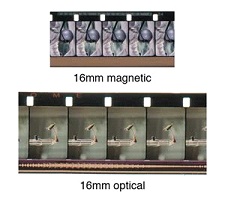
Regular 8mm movie film was never sold commercially with a sound strip but some people did attach a sound strip themselves. Super 8 film has the option but you had to buy the film with the sound strip on it and you had to have a sound camera and microphone. 16mm had both magnetic and optical. On the order form you can let us know if you think your film has sound on it. It does take extra effort to capture the sound and incorporate it into the requested formats. So, we do charge a little more for sound film.
We can not capture any digital audio like Dolby Digital or Sony Dynamic Digital Sound.


The above picture is just an example. 16mm sound film came in many different varieties. 16mm film with optical sound will have sprocket holes on 1 side. The other side will carry the audio track.
There is no sound on Regular 8 film. At least it wasn't produced that way. There were some people that put a magnetic sound strip on 8mm film themselves. There was also some test 8mm film with sound that Kodak used to prepare for Super 8 film.
Even though Super 8 film was sold in two versions, sound and silent, most Super 8 film is silent. Only about 5% of all Super 8 movie film has sound on it.
Mesa Fun Facts: Mesa, located in south-central Arizona, is the third-largest city in the state and one of America's new breed of fast growing cities. A suburb of Phoenix, Mesa is the largest suburb in the country, with a population of 400,000 with 37% growth in the 1990s. Initially inhabited by Native Americans and Spanish explorers, the area became US territory after the Mexican American War. Mormon pioneers founded the city in 1878; a large Mormon population (25%) remains there today.
Arizona Fun Facts: Arizona, the Grand Canyon state, achieved statehood on February 14, 1912, the last of the 48 coterminous United States to be admitted to the union. Originally part of New Mexico, the land was ceded to the United States in 1848, and became a separate territory in 1863. Copper was discovered in 1854, and copper mining was Arizona’s premier industry until the 1950s. After World War II, the widespread availability of refrigeration and air conditioning caused Arizona’s population to boom and Phoenix to become one of the fastest growing cities in America.





